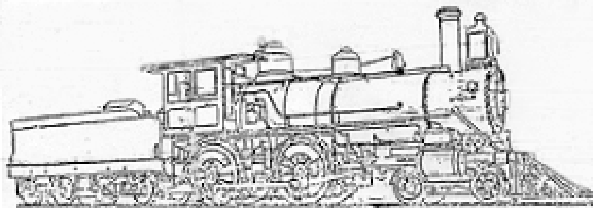
The Evening Tribune, August, 1891
Special Feature
AMERICAN RAILROADS - THEIR GROWTH THE WONDER OF THE CENTURY

MODERN PASSENGER LOCOMOTIVE
From Peter Cooper’s Engine
That Could Beat a Horse to the
Lightning Express—Evolution of the Stage Coach—
The Vestibuled Limited Has Taken Its Place.
The invention of the steam engine in 1773 attracted advanced thinkers to the possibility of the locomotive. The American Railway, published by Scribners, gives a detailed history of the growth and development of the railway system.
The first locomotive was invented in London by Richard Trevithie, 1804, but it could not make steam and could therefore neither go fast nor draw a heavy load. It was of very little practical value. But in 1820 when a competitive trial of locomotives was made on the Liverpool and Manchester Railways, the Stephensons, father and son, presented the "Rocket," which by the aid of a steam blast, which was kept constantly blowing the fire, enabled the locomotive to make steam enough to draw ten passenger cars at the rate of thirty-five miles an hour.
In this country the Delaware and Hudson Canal at Honesdale, Pa., was the pioneer in railroading, and in 1827 this company built the Carbondale Railroad under construction, connecting the coal mines with the canal. This road was sixteen miles in length and was opened in 1829, to be operated by stationary engines. The first locomotive in this country was run over this road in Aug. 9, 1829.
Mr. Horatio Allen, who is still living near York, went to England in 1828, to study the subject of locomotive building. He had a commission from the Delaware and Hudson Canal Company to purchase rails for their road and also their locomotive to be built in England, upon plans to be to be decided upon by himself after his arrival in that country. This was before the trial of the "Rocket" on the Liverpool and Manchester Railroad. The result of Mr. Allen’s investigation was to produce in his mind a confidence in the multitubular boiler which is now universally used for locomotives. An order was given to Foster, Rostuch & Co., at Stonebridge, for one engine whose boiler was to have riveted flues of comparatively large size, and another order was given to Messrs. Stephenson & Co., of Newcastle-on-Tyne, for two locomotives with boilers having small tubes. The engine built by Foster, Rostuch & Co. was sent to this country and tried at Honesdale, Aug. 9 of that year. Its name was the "Stonebridge Lion," and it was run on its trial trip by Mr. Allen, to whom belongs the distinction of having run the first locomotive ever used in this country. The two locomotives built by Messrs. Stephenson & Co. were sent to this country, but there is no record of their use.
The first railroad which was undertaken for the transportation of freight and passengers in this country on a comprehensive scale was the Baltimore and Ohio. Its construction was begun in 1828. Peter Parley’s "First Hook of History," used as a school book half a century ago, says of this first railway:
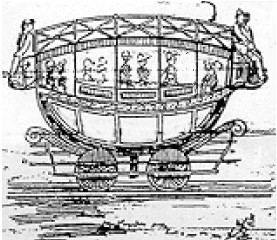
FIRST PASSENGER CAR.
"But the most curious thing at Baltimore is the railroad. I must tell you that there is a great trade between Baltimore and the States west of the Allegheny Mountains. The Western people buy a great many goods at Baltimore and send in return a great deal of Western produce. There is, therefore, a great deal of travel back and forth, and hundreds of teams are constantly occupied in transporting goods and produce to and from market. Now, in order to carry on this business more easily, the people are building what is called a railroad. This consists of iron bars laid along the ground and made fast, so that carriages with small wheels may run along upon them with facility. In this way one horse will be able to draw as much as ten horses on a common road. A part of this railway is already done, and if you choose to take a ride upon it you can do so. You will mount a car something like a stage and then you will be drawn along it by lead horses, at the rate of twelve miles an hour."
The Baltimore and Ohio had fifteen miles of road in May, 1830. The question of locomotive power was under consideration for some time.
In 1829 and 1830, Peter Cooper experimented with a little locomotive on this road. At a meeting of the Master Mochailles’ Association in New York in 1875 at the institute which bears his name—he related with great glee how, on the trial trip, he had beaten a gray horse attached to another car. The boiler of Peter Cooper’s locomotive was about the size of a flour barrel. The flues were made of gin barrels. The whole machine was not larger than a hand car of the present day.
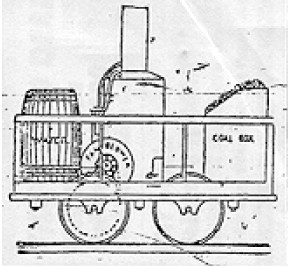
THE DEWITT CLINTON. 1831.
The "Dewitt Clinton" was built for the Mohawk and Hudson Railroad, and was the third locomotive made by the West Point Foundry Association. The first excursion trip was made with passengers from Albany to Sconactady, August 9, 1831.
In 1831 the Baltimore and Ohio Company offered a premium of $4,000 "on the most approved engine, which shall be delivered for trial on or before the 1st day of June, 1831, and $3,500 for the engine which shall be adjudged the next best."
The requirements were that the engine, when in operation should not exceed three and one half tons in weight, and must on a level road be capable of drawing fifteen tons, exclusive of weight of wagons, fifteen miles per hour.
In response to this three locomotives were produced, but only one was made to answer any useful purpose. T his engine, the "York," was built at York, Pa., and brought to Baltimore over the turnpike on wagons. After undergoing certain modifications it was found capable of performing what was required by the company.
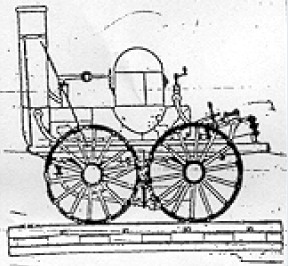
THE "PLANET."
In August, 1831, the locomotive John Bull, which was built by George and Robert Stephenson & Co., of Newcastle-on-Tyne, was received in Philadelphia for the Germany and Amboy Railroad and Transportation Company. This is the old engine which was exhibited by the Pennsylvania Railroad Company at the Centennial Exposition of 1876. After the arrival of John Bull a number of engines were imported to America by the Stephensons. Most of them were of what is known as the "Planet," which was a form of engine which succeeded the "Rocket."
In all these locomotives the axles were held by the frames so that the former were always parallel with each other. This made it difficult to turn curves.
This was remedied by John H. Jervis, who constructed an engine with a main driving axle rigidly attached to the engine frame, and only one truck or "bearing carriage" consisting of two pairs of small wheels attached to a frame and fastened to the engine frame by a king-bolt
In 1834 Ross Winans of Baltimore, patented the application of the principle which Mr. Allen had proposed and adopted for locomotives "to passenger and other cars." He afterwards brought a number of actions at law against railroads for infringements of his patent, which was a subject of legal controversy for twenty years. Winans claimed that his invention originated as far back as 1831 and was completed and reduced to practice in 1834. The dispute was carried to the Supreme Court of the United States and was decided against the plaintiff after an expenditure of $200,000. It involved the principle in which nearly all cars in this country are now and were then built.
In 1834 Henry R. Cambell of Philadelphia, patented the use of two pairs of driving wheels and a truck. The driving wheels were coupled by rods. the principle has generally been adopted in this country.
From these comparatively small beginnings the magnificent equipment of our railroads has grown. From Peter Cooper’s locomotive, which weighed less than a ton, with a boiler the size of a barrel, and which had difficulty beating a gray horse, we now have a locomotive which will easily run sixty and can easily exceed seventy miles an hour, and others which weigh seventy-five tons and more.
A comparison of the engine built by Peter Cooper with the modern standard express passenger locomotive shows the progress which has been made in fifty years. There have been many modifications in the design of locomotives to adapt them to the changed conditions of the various kinds of traffic today. An express train traveling at a high rate of speed requires a locomotive very different from one which is designed for hauling heavy freight cars up steep mountain grades. The engines at first had four wheels, but now they have eight and ten.
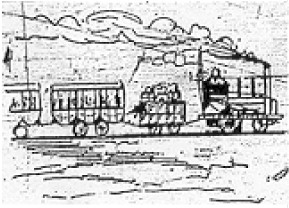
BOSTON & WOURCHESTER R. R., 1835
The early cars resembled the stage coaches of that day. The Mohawk and Hudson Road in 1831 had had six cars similar to that represented in the engraving. the next step was to join these coaches together, and build cars with compartments. It was opened Sept. 27, 1825, with a "good train"," as the freight train is called in England, but this also carried a number of passengers.
The following notice, which appeared in the Baltimore newspapers, was the first time-table for passenger railway trains published in this country:
"RAILROAD NOTICE.
"A sufficient number of cars being now ready for the accommodation of passengers, notice is hearby given that the following arrangements for arrival and departure of carriage have been adopted, and will take effect on, and after Monday morning next, the first instant after, viz. A brigade of cars will leave the depot on Pratt street at 6 and 10 o’clock a.m. and 4 o’clock p.m.. and will leave the depot at Ellicott’s Mills at 6 and 8 1/2 o’clock a.m. and at 12 1/2 and 6 p.m.
"Way passengers will provide themselves with tickets at the office of the company in Baltimore, or at depots at Pratt street and Ellicott’s Mills, or at the Relay House, near Elk’s Ridge Landing.
The evening way car for Ellicott’s Mills will continue to leave the depot, Pratt street, at 6 o’clock p.m. as usual.
"N.B. Positive orders have been issued to drivers to receive no passengers into any of the cars without tickets.
"P.S. Parties desiring to engage a car for the day can be accommodated after July 5."
A passenger train of the Mohawk and Hudson Railroad which was put on in October, 1831, between Albany and Schenectady, attracted much attention. It was hauled by the English engine, "John Bull," and driven by an English engineer named John Hampson. This is generally regarded as the first fully equipped passenger train hauled by a steam power engine which ran in regular service in this country. During 1832 it carried an average of 387 passengers daily. The accompanying engraving is from a sketch made at the time.
From this train to the New York limited vestibuled sleepers, parlor car, dining car, library, bathroom, and barber shop, marks the advancement of railway time in America in half a century.
Evening Tribune Front Page Next Section